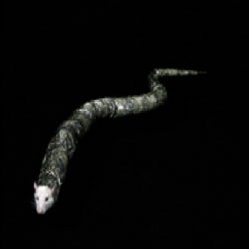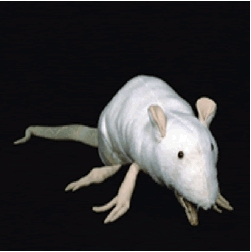Feature: Reviews
Smelling a Rat: Nina Katchadourian
- Catharine Clark Gallery
- San Francisco
- November 20, 2003 - January 3, 2004
Animal Crossdressing, Uninvited Collaborations with Nature, and One Small Act of Endurance
Nina Katchadourian’s latest poke at the perversity of man-made nature, Animal Crossdressing, Uninvited Collaborations with Nature, and One Small Act of Endurance, contains multiple bodies of work, and a multiple division of focus, as the title implies. With hyperbolic teasing, the photographs, video, and sculpture scrutinize artificial behavior, unnatural environments, and the psychology of human interference.
The show has five distinct parts, each of which can be connected obliquely to the centrally hung image Quit Using Us. This piece consists only of its own title, comically spelled out with caterpillars over a red background one could imagine to be the blood of Disney animal martyrs. Its nursery whine against an unnamed exploitation, which initially strikes the viewer as a kind of bogus laugh, is also the best analytic glue for holding all corners of this exhibit together. It suggests that the subject of use and misuse is the butterfly net with which all of Katchadourian’s experiments might be caught. The methodical playfulness throughout the work is a bit distracting, but only transparently misleading. Katchadourian’s burlesque is a cover for sincerity, not a Da-Daist’s affection for prank oddity.
In multiple rooms of the gallery are pieces of the “Animal Crossdressing” series, a collection of photographs, two costumes, and a video, which catalog the literal dressing of a rat as a snake, and of a snake as a rat. It is a corrupt bestiary of a sort, defining hierarchical models through predator/prey reversal. The more dimensional of the two role-plays here is taken by the snake. While the rat is forced to bluff an appearance more threatening than he can substantiate, the snake claims a reduction of power that potentially makes him even more threatening. In the video, the rat resists entering his costume while the snake is docile, admitting that it is actually easier to assume the role of victim rather than that of an aggressor. Both types of mimicry occur in nature, such as the Caligo butterfly, whose wing design imitates the eyes of an owl, or certain types of spiders who smell, move, and look like ants in order to invade nests and eat their babies. Katchadourian’s snake, however, entertainingly fails to appear legitimately vulnerable at all, due to the sheer size of the rat costume that it must assume.
This failure to stage harmlessness is reiterated in the performance video Endurance, where Katchadourian holds a stiff grin for ten straight minutes. Here, the vicarious experience for the viewer of disguising, challenging, or modifying one’s own predatory nature is more distressingly presented. Her smile begins as the spare “I’m Okay, You’re Okay” social costume, but tightens into something less identifiable, and quickly becomes a purely fearful and painful tugging of her skin and lips. Archival footage of the disastrous 1914 Endurance expedition is projected on her open mouth like one gold tooth. This voyage, which left the crew as castaways in the Antarctic after the ship was crushed in the ice pack, was led by explorer Sir Ernest Shackleton. Shackleton’s ironic family motto, “By endurance we conquer,” serves as an unusual companion to the knowledge that facial expressions generally last no longer than 2.5 seconds. Are we being asked to see Katchadourian as a kind of tongue-in-cheek explorer of the unclaimed territories of human sentiment? The hollow smile, an autonomic insistence of good intention, or even pacifism, is perhaps animal mimicry in its most modern and most invisible evolution. The drooling isometrics of the performance exaggerate the failure of faces to tell the truth, but also their failure to lie.
The disguise of character is also a feature of another video, Ant Static, which is a composite of one hundred video layers of frenzied ants. Behavior is structured not through the artificial extension of its appearance, as in Endurance, but through artificial compilation. This cloud of collaborative movement appears to be a botched test, an entirely irrational and incapable vision. The muddy repetitions of activity, one seen through another, as on a light box, are sped up unintelligibly, disguising exactly what we can imagine it might have set out to define. Indeed, the twitching spots on the video look more like sperm cells than ants, an amusing admission of the vanity and anthropomorphism of human observation. In this way, Ant Static can almost be seen as a loose metaphor for Heisenberg’s Uncertainty Principle, which explains how an observer necessarily interferes with what he is observing, and compromises his own ability to accurately see what is present.
Heisenberg claimed that any concept only has meaning within the structure of the experiments used to examine it. In the way that Katchadourian reduces her surveillance of ants exclusively to uncertain relationships, we see mostly evidence of the perversity of the observer, not the traits of the observed. The confusing visual negotiation in Ant Static between indeterminate position and indeterminate movement can also be seen to address Heisenberg’s argument that precise position and precise velocity cannot both be known simultaneously.
This video is epistemological to the extent that it questions the validity and value of our intellectual history with, and business with, the “natural world.” With this video, and throughout the entire exhibit, we are led to consider that the study of nature is used somewhat as a tool of condescension, somewhat as a tool of amusement, and somewhat as a tool of vicarious admission—a way to look at human behavior safely through the lens of things essentially detached from it. This becomes a way to wipe our feet of the confusing contradictions of multiple human identity, by splitting it up, and creating simple associative declarations. Ants are chaotic. A snake is a predator. Rats carry disease. It is especially efficient to think this way when, according to Heisenberg, observation itself is a compromise of precise understanding.
On the gallery floor in the back room is an installation of stones fitted with resin rock climbing wall grips, called Parasite. Two photographs document similar installations in a shaded woodland grove. The climbing grips, made purposeless and decorative in a space with no practical route for ascension, appear to ridicule Goldsworthian ornamentalism. More broadly, Parasite ridicules the intellectual captivity we embrace in the way that we perceive things to be the summary of their utilities. These climbing grips are cutely blue, not rock-colored. They are playpen imitations of natural forms and meant to be seen only as imitations, not true impersonators. They are the symbiosis between a concept of rocks and an employment value of rocks. The parasite here is, again, the human mind, with its jurisdiction of conception, and its blanket inclination to “live off the land.”
The final component of the exhibit is a series of four photographs called Birdhouse/Outhouse: The Semiotics of the Forest. The four compositions are exactly the same, featuring an outhouse and a birdhouse in a forest setting, with alternating positioning of the doors and locks on the two structures. Within the comparison between these manmade shelters there are two themes incorporated. One places occupation against vacancy, and explores how the use of a space is a phenomenological question. The creation of these structures has nothing to do with what is objectively natural. The second subject of these photos is the role of manufactured habitat as it services the division of behavior into subcategories. The birds have their perceived domestic activities redefined by an intended acquisition of personal property. Building birdhouses is a way of isolating for them a “home life,” attributing to them our own interest in “nesting,” and for making their existence auxiliary to our own. Yet even as we connect the nature of birds to ourselves, we reject our own roots back to nature. This is not necessarily contrary. The shelter built for human use here is a communal sanctuary prepared solely for the self-conscious act of defecation. It is our need to hide parts of our own nature that makes us reach out to find analogous conduct in the natural world. The birdhouse and the outhouse are tools for this way of thinking. These shrines for the segregation of individual actions from the sum of behavior are not only an aspect of the way we qualify behavior, but our way of possessing it. The birdhouse is not really a home for birds, of course, but a storage place for our mental custody of them.
Katchadourian acknowledges, in conversation about the work, that her various photographs, videos, and installations don’t always seamlessly fit together as one conceptual sentence. There is worth in the gaps between her pieces, and the web of messages is bounded by the idea of unselected behavior, and the perversity of control. The only clumsiness here is the discomfort with which the exhibit as a whole lingers between admitting a more unifying theme, and resisting its latent potential to acquire one. The artworks do not complete each other sequentially. We can question this as a failure of resolution. But in doing so, we devalue the intellectual honesty of an untidy argument. We should consider if stricter message discipline is even necessary.



